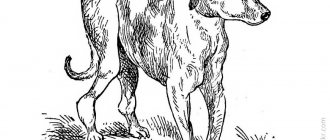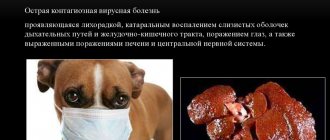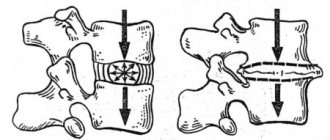Distemper in dogs is a dangerous disease that is accompanied by severe symptoms and long and expensive treatment.
The probability of death of an animal ranges from 50% to 90%, depending on how strong the immune system is and how quickly therapy was started.
The scientific name of the pathology is viral canine distemper (VCF) or Carré's disease. It is caused by a paramyxovirus. It is genetically similar to the causative agents of rinderpest, as well as measles in humans, but is not transmitted to humans.
Prevention measures
At home, prevention involves following basic precautions. Traditionally, distemper is transmitted from animal to animal by airborne droplets, but there are other methods of infection. Your pet can “catch” the disease from the following sources:
- dirty water;
- poor quality food;
- urine;
- fecal discharge (for example, during sniffing);
- hygiene items for other dogs (combs, washcloths, bowls).
Experts also note that in addition to a dog, a wild animal can also infect your pet with plague. Among the main carriers, the most common are fox, wolf, arctic fox, and mink.
To prevent infection from occurring, monitor the quality of the animal’s diet and also keep the premises in order. Especially if you have several dogs living in your house. Do not allow personal items of a sick animal to be used in caring for a healthy one.
While walking, keep an eye on who your pet comes in contact with. Do not allow your dog to be bitten by strange dogs or fights in general. Animal interaction, contact with the mucous membrane of an infected individual, etc. is fraught with disastrous consequences.
Experts note that you can bring the virus on yourself. For this reason, an additional preventive measure is to carefully care for your own clothes and shoes. Regularly wash your outerwear (especially walking clothes) and clean your boots.
Important: of course, an important measure of protection against distemper in dogs is timely vaccination.
FAQ
Is canine distemper transmitted to humans and other animals?
The virus does not pose any danger to humans. And it is transmitted to other animals if they are canines, since the virus is specific to them. But do not forget that any animals, as well as people, can become carriers of the virus.
Is distemper treatable in dogs and what is its incubation period?
Yes, it is possible to cure if it is not a hyperacute form and you turn to specialists in time. The incubation period lasts 2-3 weeks, sometimes longer.
What to feed a dog with distemper?
Nutrition is very important during illness and should contain as many vitamins as possible. If possible, you can give meat. If the dog refuses to eat, we feed it with a syringe without a needle with specially developed pates from the line of veterinary diets.
Can a vaccinated dog get distemper?
No vaccine provides 100% protection against the virus. But vaccinated dogs get sick much easier, sometimes even unnoticed by the owner. It may simply be a mild gastrointestinal disorder for 1-2 days, without other clinical symptoms
Can it be cured with vodka?
No! Of course, ethanol is used for medicinal purposes, but not in this form and not in this case!
How much does a vaccination cost?
You need to find out prices for vaccination specifically at the clinic where you are going to go.
How often should I get vaccinated?
Anti-distemper drugs are included in complex vaccines and should be injected according to the scheme described in the instructions. Recommended vaccination schedule: 8 weeks, 11 weeks, 15 weeks, then 12 months after the last vaccination.
How long do dogs live after distemper?
Depends on what consequences the disease left behind. If the plague occurred with nervous symptoms, then a tic, or loss of vision, etc. can remain with the pet for life and affect the quality and number of years lived.
How to treat the booth?
The place where the sick dog is kept must be treated with a 2% formaldehyde solution, and the bowls must be boiled.
Vaccination against distemper
Vaccination is one of the key factors in protecting a dog from distemper infection at any age. In addition, this is a pass for the owner and his pet to exhibitions. A vaccination record is also required if you decide to take your four-legged friend on a trip.
The first vaccination is performed at the age of 2-3 months, the second - at intervals of two weeks. They help support the puppy's weakened immune system. The next vaccination is performed after changing teeth, and then an individual schedule for visiting the veterinarian is developed.
The most effective vaccines are Nobivac DHP, Dipentavak, Biovac-DPA. It is important to remember that any vaccination is given to a dog that is free of worms. Therefore, if your pet is infected with helminths, you must first take care of their elimination. Many doctors, by the way, recommend that all dogs without exception be given anthelmintic tablets before vaccination. This is both treatment and additional prevention.
It is not recommended to vaccinate a sick dog. Fever, lethargy, and general malaise are all signs of illness and decreased immunity.
Do not rush to walk your dog immediately after visiting the clinic. You will have to stay at home for at least 10 more days. This is explained by the increased vulnerability of a newly vaccinated animal.
Remember that vaccination is very important for your dog. This does not mean that after vaccination the dog will not get sick at all, but if infected, the disease will most likely be mild.
Rehabilitation after suffering from plague
After suffering a viral infection, the consequences can last a lifetime. It is very important to completely cure your pet without relying on chance. It is important to follow all the veterinarian’s recommendations during the rehabilitation period - strengthen the immune system, establish a proper diet, avoid contact with other animals (quarantine keeping, which will not only prevent infection of other pets, but will also prevent complications from developing).
The body is very weakened after suffering from plague, so the owner’s task is to prevent the development of serious consequences. After an animal has recovered from the distemper virus, tumors may appear in the oral cavity, and tooth enamel may darken.
If you do not follow all the specialist’s recommendations, after the first infection, the dog may get sick again, but in this case, with a severe nervous form of the pathology.
This occurs as a result of incomplete cure and prolonged existence of the virus in cells. During the rehabilitation process, it is possible to develop serious diseases, such as meningitis or encephalitis, against the background of incomplete recovery.
Proper nutrition
Another additional method of prevention is organizing proper nutrition. Your pet's body will need strength to resist the virus, so take care of a balanced diet.
Your pet can get the required amount of protein every day not only from meat, but also from cottage cheese. The daily requirement of dietary vitamins is contained in raw liver, and the dog can get the required amount of iron from semolina. Millet is a source of nicotinic acid, buckwheat is a source of lecithin, etc. In general, food should be varied.
Good advice: do not use only ready-made mixtures and especially dry food in your dog’s diet. Along with ready-made store-bought delicacies, the animal should also receive regular cereals and stews. Such food has a positive effect on digestion. Don't forget about water, especially if dry food is present in the diet.
It is important to know
Many people know about distemper, and most often there is only one conclusion - the animal is sentenced to death. Unfortunately, there are a lot of deaths, but they also account for the percentage of surviving and healthy dogs.
If there are other dogs living in the house, isolate them for a while. The best solution would be to conduct an ELISA and PCR test, which will confirm the absence of the virus in the body of other pets. Sick and healthy animals should not live in the same area. You can transfer the virus from one room to another, thereby putting your pet’s health at risk. Canine distemper is not dangerous for humans and cats. You cannot get the virus.
How the disease is transmitted
The main risk group for infection with canine distemper includes puppies aged 2 months to a year. The weakened immunity of children cannot yet withstand a strong virus. Often, unfortunately, infected puppies die. But animals older than 3 years are distinguished by better health; here the survival rate is higher.
If we talk about animal breeds, more often it is purebred dogs with a pedigree that become victims of this disease. True, mortality statistics differ for different breeds. Thus, among bulldogs the survival rate reaches about 90%, while among Great Danes and Coppers this figure is significantly lower. Ordinary mongrels, not pampered by comfort, enjoy good health along with bulldogs. On average, the mortality rate is 40-80%.
Most often, spread occurs through contact with a sick or previously ill animal. As mentioned above, the virus is transmitted by airborne droplets, and therefore often travels through shared bowls, during dog interactions, or as a result of aggressive animal collisions.
The standard incubation period is short, only 3-7 days. In rare cases, the disease may appear 3 months after infection.
Danger to humans
The virus is dangerous to all carnivores and rodents. At risk are dogs, cats, rats, badgers, foxes, ferrets, mongooses, arctic foxes, raccoons and other forest inhabitants. This infection is not transmitted to people, although single cases of infection have been recorded in America and Asia. Scientists believe that strains influence the development of multiple sclerosis; the theory has not been proven.
It is almost impossible to pick up distemper from a pet, but it is better to maintain a distance when in contact: examine only with gloves, thoroughly clean your hands with alcohol, and communicate through a medical mask.
The dog is sick
Initially, only the mucous membranes and lymph nodes are affected. At the same time, the canine distemper virus cannot be considered as a disease of any particular group of organs. This is a complex lesion of the entire body.
In the early stages, the disease settles on the submandibular and bronchial mucous membranes. The further route of microbes runs into the blood vessels and lymph nodes, and from there throughout the body.
During canine distemper, the respiratory tract, immune system, digestive organs, endocrine and nervous systems are most affected. The pet has a severe depletion of immunity, immunodeficiency.
Who is at risk?
Any dog can get distemper: young, adult, elderly, purebred, mongrel.
The following are especially likely to be affected:
- puppies up to one year;
- old dogs;
- pets weakened by another disease;
- animals that live in unsanitary conditions or have poor nutrition.
The most susceptible to canine distemper are shepherd dogs, collies, huskies, poodles, staff dogs, and Pekingese dogs. Hunting breeds are at high risk because they come into contact with wild animals.
The disease most rarely affects terriers and mongrels, due to the fact that stray bitches often get distemper and pass on antigens to puppies with colostrum.
HPV is not contagious to people. Cats do not get sick from it either, although they are carriers: purrs have their own plague - panleukopenia, which is caused by a different strain.
Dog after illness
In surviving dogs, distemper, unfortunately, does not go away without leaving a trace. As a rule, after contracting the virus, the animal remains disabled. Most often, a dog loses hearing, vision, or loses its sense of smell. If your pet has suffered from severe distemper, then a muscle twitching (also known as chorea, also known as St. Vitus’s dance) may remain a reminder of the virus. The most severe consequence is mental disorder and personality degeneration.
Symptoms
Take a closer look at your pet if:
- during the day he looks tired and lethargic;
- suddenly began to eat poorly;
- vomited;
- The dog's nose is leaking and his eyes are watering;
- the dog avoids sunlight, hides from bright rays, as if it hurts his eyes;
- dizziness is observed (temporary symptom);
- the dog feels like he is being chased (temporary symptom);
- diarrhea (stools are dark in color and have a strong unpleasant odor).
Signs of a virus taking root in the body may include the appearance of pustules on the skin, inflammation on the nose and mouth. A week after infection, discharge from the eyes and nose intensifies, the dog’s temperature rises to 39-40 ° C, chills and a dry cough appear. In this case, the animal often experiences severe thirst. The nose is usually dry during this period.
The main symptoms of plague, which has spread throughout the body, are nervous tics, and in some cases, paralysis of the limbs. The presence of these signs indicates one thing: the virus has penetrated the brain and spinal cord.
It would seem that the symptoms are quite clear, but in the early stages it is not so easy to identify a serious disease. In order not to miss the situation, assess the condition of your pet as a whole. So, if at the same time he has diarrhea, discharge from the eyes and nose, sneezing and chills, it is most likely distemper. It is recommended to be especially vigilant if the dog is exposed to a pathogenic environment or has had contact with a sick or already ill animal.
Symptoms and possible complications
For a positive prognosis, it is necessary to inject an antiviral drug as early as possible. The maximum effectiveness of the administered medication is achieved only in the first days after the onset of the disease. If you find at least one of the listed signs in your pet, contact a veterinary clinic immediately.
First signs
Drug therapy at the initial stage helps in 90% of cases. The first signs of distemper in dogs include:
- disheveled wool;
- increased tearing of the eyes and the appearance of nasal discharge;
- swelling and redness of the eyes;
- fever and loss of appetite;
- apathy and depression;
- photophobia (the animal avoids sunlight and hides in dark places);
- cough;
- diarrhea with yellow excrement containing pieces of undigested food or blood clots.
The number and severity of symptoms varies individually. It depends on age, breed, immune status and many other factors. If signs of damage to the nervous system (convulsions, paralysis) are added to the listed symptoms, the chances of saving the pet are minimal, but it is still worth fighting for the dog’s life.
Which organs are most affected?
The greatest impact of distemper in dogs occurs on the respiratory tract, central nervous system and gastrointestinal tract. Negative consequences are possible even after recovery. Animals that have recovered from the disease may lose their vision and develop lameness along with epileptic seizures. Not all owners are ready to endure such consequences, therefore, when the spinal cord and brain are damaged, euthanasia is chosen.
Forms of plague
Depending on the set of certain symptoms, several types of Carré disease are distinguished.
Nervous distemper in dogs
The symptoms of this type of disease are clearly distinguishable. The main signs of nervous distemper are characteristic muscle twitching and nervous tics. The dog may suddenly become lame and there may be spasms in the limbs. If the disease is advanced, the animal's hind legs may stop working. Subsequently, the dog stops moving altogether, then paralysis of the heart and respiratory tract occurs.
Pneumonic distemper in dogs
Pneumonic plague is accompanied by fever, purulent discharge from the nose and eyes, and stomach upsets. A characteristic sign of pneumonic plague is refusal to eat and constant thirst. In general, the animal looks lethargic and apathetic. It is important that with the transient form of distemper, within a few days after the onset of the disease, the dog does not get up and coughs constantly. Often in this case the limbs refuse to work. After approximately 5-6 weeks of the disease, death occurs.
Intestinal distemper in dogs
The main symptom of intestinal plague is continuous thirst accompanied by an almost complete refusal to eat. The dog's water consumption becomes uncontrollable. An animal can literally drink to the point of vomiting. Intestinal plague is also characterized by diarrhea and indigestion. The discharge has a strong, unpleasant odor.
Implicit symptoms of this form include fever, the appearance of a white coating on the tongue, and periodic loss of consciousness. During distemper, your dog's teeth may develop depressions or stains. The oral cavity as a whole changes its appearance.
Cutaneous distemper in dogs
This form of distemper is considered the safest of all and resembles the plague that affects people. A clear sign of the skin form of the disease is the appearance of abscesses and rashes throughout the animal’s body. After some time, the abscesses burst and turn into ulcers. The ulcers, in turn, gradually become crusty. Infected wounds may bleed and secrete pus.
Active and dried sores cause considerable discomfort to the dog, making it irritable and aggressive. When the disease is advanced, the animal experiences rapid fatigue, fever, and lethargy. Pus begins to flow from the nose and eyes.
Main forms and signs of the disease
As a rule, with such a dangerous disease as distemper, symptoms begin to appear long before the pet’s condition clearly deteriorates, of course, if this is not a lightning-fast course of the disease.
If you pay attention to changes in your pet’s behavior and condition in time, then the likelihood of severe complications occurring is almost zero, and the likelihood of a cure is 100%.
Very often, the very first signs go unnoticed and dog owners do not pay attention to them. Well, just think, the puppy coughed, sneezed, or there was a little mucus flowing from his nose or his eyes turned red. Many people write this off as a common cold, when it could be much more serious.
If the animal's condition worsens, take the time to measure its temperature and carefully examine the dog. But it’s best to play it safe and go to a veterinary clinic and get tested, especially if you have a puppy.
Next, about the main forms of the disease.
Enteropulmonary form of plague
The enteropulmonary form of plague is considered typical and is the most common. In most cases, the virus affects the intestines and respiratory system, which leads to digestive and respiratory problems. As a rule, the symptoms are mixed. But in one animal the intestines may be more affected, while in another the respiratory system.
The first symptoms of the enteropulmonary form of the disease, as a rule, begin to appear quite quickly - 2-3 days after infection.
The first signs of damage to the gastrointestinal tract
The first signs of gastrointestinal damage are very similar to signs of poisoning:
- Yellowish mucous and sometimes bloody, very foul-smelling diarrhea.
- Due to frequent diarrhea, dehydration occurs, causing the animal to suffer from constant thirst.
- Vomiting foam or mucus streaked with blood.
- Refusal to feed, depressed state.
The first signs of damage to the respiratory system
Let's list them:
- Blockage of the nasal passages. Initially, the clear mucous discharge becomes purulent and thick, greenish or gray in color. The leaking mucus causes crusts to form along the edges of the nose and cracks may appear. Touching the nose causes pain in your pet.
- My eyes begin to water. Transparent and liquid tears gradually turn into purulent discharge. The eyelids stick together so that the dog cannot open them. This is especially noticeable after sleep.
- Possible clouding of the cornea of the eyes.
- A hysterical, paroxysmal cough. Coughing attacks can cause vomiting and even fainting.
- The throat turns red and the tonsils become enlarged.
- Shortness of breath appears, wheezing is heard in the chest and, as a consequence, complications - bronchopneumonia.
- Throughout the day, body temperature can change abruptly: sometimes it rises to 42°C, sometimes it returns to normal.
After the first signs begin to appear, it may take 3 to 7 days before things get worse.
Cutaneous plague
This form of plague is considered the mildest. The pet does not cough or sneeze. The gastrointestinal tract is normal. However, rashes may appear on the skin, causing pain and causing great inconvenience to the pet:
- Reddish blisters filled with liquid appear on the skin. Blisters may appear on the thighs, abdomen, ears, around the nose and mouth. Later, a crust forms in place of the burst blisters.
- Possible focal baldness.
- The skin on the paw pads may also crack.
- Calluses may form on the elbows and hock joints.
Although the skin form is considered the most harmless, the pet’s health can be undermined by secondary infections (bacteria or fungi) that can appear on the affected areas of the skin.
Nervous form of plague
The most unfavorable prognosis is made when the pet begins to show signs of the nervous form of distemper, since in 50% of cases the central nervous system of the animal is affected. The highest probability of outcome with this form of plague is the death of the animal. And in case of recovery, residual effects are possible: difficulty breathing, weak limbs or even their failure, involuntary urination, and so on.
The disease itself can cause terrible complications in the form of meningitis, encephalitis, paralysis and epilepsy.
As a rule, in healthy dogs, symptoms begin to appear only 3-4 weeks after infection. But in weakened quadrupeds almost immediately. If you do not pay attention to the first signs of the manifestation of the nervous form of Carré disease in time and do not provide medical assistance, then in most cases the prognosis is quite disappointing.
Signs of the nervous form of plague
Here they are:
- The first signs are tics of the limbs and head muscles. Gradually the intensity of the tics increases. If tics are present, this form of plague is easily diagnosed.
- Weakness of the limbs, unsteady gait, trembling and muscle spasms, convulsions, and epileptic seizures are possible.
- Along with fever and convulsions, a disorder of the vestibular apparatus may appear. The dog behaves as if it is catching flies that do not exist. And this already indicates the appearance of complications such as meningitis or encephalitis.
- Skin sensitivity decreases.
- The dog is afraid of the light, tries to hide in a dark corner in search of peace.
- A state of excitement or aggression may be replaced by drowsiness. The animal begins to whine.
- Body temperature rises to 42°C and remains constant.
- The animal falls into a coma and, without leaving this state, dies.
Canine plague is a very deceptive disease. All of the above divisions into its various forms are quite arbitrary. Do not think that the first signs of plague will begin to develop in a typical enteropulmonary form: discharge from the eyes, cough and diarrhea. The plague can begin with the appearance of one or several signs at once: runny nose, diarrhea, fever, skin rashes, depression, and so on.
The pet's condition can be changeable. The apparent calm and subsidence of symptoms may result in new attacks and deterioration. Therefore, if one or more similar symptoms appear, you should not wait and observe the four-legged condition, especially if you have a small puppy.
In order for recovery to be guaranteed, you need to urgently see a veterinarian and start treatment on time. Or play it safe, get tested and make sure it’s not the plague.
Variants of the course of the disease
To date, 4 forms of distemper in dogs have been identified:
- lightning;
- apathetic;
- acute;
- chronic.
Each option has its own set of symptoms. Let's look at them to be savvy in any situation.
1. Lightning fast
This type of disease is perhaps the most elusive. Outwardly, the dog practically does not betray its condition. She can be active, playful, sociable. As a rule, with this course of the disease, only a refusal to eat is observed, but in most cases the owners do not have time to focus on this. Within a few days after infection, the animal dies. Sudden death is often attributed to cardiac arrest. The true cause can only be revealed through detailed research.
2. Apathetic
Another hidden form of plague. However, unlike the fulminant type, in this form the disease can last up to several months. For example, a dog may begin to limp, but this will go away within a day or two. Other symptoms appear and disappear, dulling the owner’s vigilance. As a result, the already advanced disease enters the lightning stage, and the animal suddenly dies.
3. Spicy
This is the so-called classic Carré disease. In this case, all the symptoms are visible and appear in combination. If the owner acts correctly, there is every chance of saving the pet.
4. Chronic
Unlike the apathetic form, all symptoms are present, but they are expressed implicitly. If you are attentive to your pet, you can detect the disease, but often the disease clearly manifests itself at the last stage and develops into an acute form.
What kind of disease is this
Acute viral disease caused by paramyxovirus. It is structurally similar to the virus that causes measles. Plague can be dangerous not only for dogs; there is a subtype of the infection that affects cats and cattle. Carriers can be both domestic and wild animals (foxes, squirrels, hedgehogs, ferrets, even lions).
The disease was first discovered in Russia in Crimea in 1762, when it was called Crimean fever. Research into the virus began only in the 20th century. The French scientist Carré described a disease that causes damage to the central nervous system, rash and pneumonia.
A dog of any age can become infected; the most dangerous period is considered to be 2-5 months of age. Immunity is given by the mother for 2-3 weeks . The body's resistance is high while the puppy drinks milk, and after weaning it declines, lasting about 14 days. Then a vaccine is required.
There is a theory that the risk of infection depends on the breed. For example, the lowest frequency of infections is among terriers and boxers. Domesticated and decorative species reflect the virus quite well.
The main problem is the incredible resistance of the virus. It only dies when boiled. Even after recovery, the concentration of the pathogen in the animal’s blood is high enough to infect others. The most dangerous waste products of a pet are urine and feces.
Ways and methods of infection with the virus
Often, the virus is picked up in winter or autumn. The pathogen is resistant to low temperatures, but dies at high temperatures. The appearance and development of the disease is positively influenced by poor nutrition, untreated immune diseases, poor quality care and maintenance of the pet. Puppies born from a mother who has been ill or vaccinated are considered resistant to distemper.
A dog can become infected with distemper in 2 main ways:
- Through consumption of contaminated food;
- Through the respiratory tract.
An animal can contract the virus both through contact with other dogs and indirectly. Therefore, there is a high chance of infection, even if the dog sniffs or licks something that contains harmful bacteria. The virus can remain in the external environment for a long time. Due to this, infection occurs even in the area where an infected dog defecated or dropped saliva a few days ago.
Treatment of distemper in dogs, antibiotics
During treatment, arrange appropriate conditions in the room where the dog is kept. The room should be regularly ventilated, while trying to avoid drafts. Provide your pet with liquid food at room temperature. These are mainly soups and cereals, drinking plenty of fluids.
If purulent discharge begins to flow from the eyes and nose, regularly lubricate them with a tampon with warm water; you can use eye drops and tea. Avoid the formation of crusts, which subsequently crack and allow new bacteria and diseases into the body. If crusts and cracks do appear, regularly lubricate them with ointments as prescribed by your doctor. It is recommended to give Regidron solution to prevent dehydration in case of stomach upset.
With the normal course of the disease and careful care, the plague goes away within a few weeks. The doctor may prescribe antibiotic treatment, including IV drips.
Diagnosis of canine distemper
The diagnosis of distemper in an animal is made on the basis of epidemiological data, clinical signs, pathological changes and laboratory test results.
To make a diagnosis based on clinical signs, the veterinarian takes into account the following criteria::
- Damage to the respiratory organs;
- Catarrhal gastroenteritis (inflammation of the mucous membrane of the stomach and intestines)
- Catarrh of the mucous membranes of the eyes and nose with serous or purulent discharge;
- Hyperkeratosis of the paw pads, fingers, nose and entire skin with the formation of a large amount of dandruff;
- Damage to the central nervous system with convulsions, epilepsy, paresis, paralysis, meningitis and meningoencephalitis.
If any four or five of these signs are noticed in a dog, then they indicate the occurrence of distemper. Based on two of the listed signs, a disease can be suspected, and based on three, a clinical diagnosis can be made.
Treatment with vodka
Traditional treatment in our country is often not particularly varied: moxibustion with vodka, vodka compresses, vodka inside, outside, jars of vodka, etc. Of course, alcohol-containing products are a kind of disinfectant, and doses of alcohol in the body are known to dilate blood vessels, supposedly destroy microbes, etc. Apparently this is why when dogs become ill they also try to treat them with vodka. The method of treating distemper in dogs with vodka is extremely simple: take a syringe, fill it with vodka and pour it into the dog’s mouth. I don’t think it’s worth hoping that the dog will snack or be happy about this turn of events; the medical value of such experiments is also questionable. I don’t think it’s worth answering for the fact that vodka will help a dog recover from distemper. But in any case, the choice is yours.
Recovery prognosis
Canine plague is one of the most difficult diseases to treat. The probability of death is very high: even with timely initiation of therapy, it is 50%. Without professional treatment in a veterinary clinic, 80% - 90% of animals die.
Immunity plays a big role in recovery. The stronger it is, the greater the dog’s chances of recovery.
Every fifth dog who recovers from the disease develops complications. Which ones exactly depend on the form of the plague. Since the most serious consequences are the nervous type of HCP, it is advisable to overcome the pathology before it reaches this stage.
Biology of the pathogen and epidemiological data
The causative agent of canine plague is an RNA virus belonging to the genus Morbilliviruses (family of Paramyxoviruses). This group also includes human measles viruses and rinderpest viruses. There are two viral proteins H and F on the surface of the chemical compound.
Protein H (hemagglutinin) with a molecular weight of 76 kDa performs the function of attachment to the so-called target cell. The protein has good variability, making it easily attached to different tissues.
The F (fusion) protein with a molecular weight of 62 kDa is responsible for the fusion of the affected cell and the virus, as well as the further spread of infected cells in the body.
It is noteworthy that the virus is resistant to external factors, especially in dried or frozen form. In this form, it can be active for 3-4 months. But if the environment is heated to 56°, then within 1.5 hours it will die. At 37-40°, the elimination of the virus occurs after 15 days. A 1% formaldehyde solution helps get rid of it in just 3 hours. A 2% NaOH solution can kill the disease in just 1 hour.
What is the causative agent of the disease
Paramyxovirus (contained in the body's RNA) is the main and only causative agent of the fatal disease. A characteristic feature of the pathogen is increased resistance to external influences, preservation of all harmful parameters in almost any environmental conditions. The only effective influence that destroys the virus completely is boiling water! The first rule: when caring for a sick animal, it is necessary to regularly and thoroughly disinfect it, cleaning dishes, bowls, toys and other objects surrounding the pet. Sterility and constant disinfection increases the likelihood of getting rid of the disease.
The viral disease is extremely dangerous and has amazing persistence. After the dog has fully recovered, the dangerous elements of the disease carrier remain in the body, manifesting itself in all sorts of secretions - saliva, feces, urine. All these feces pose the highest danger to healthy individuals.
The canine distemper virus is characterized by:
- The ability to reproduce very quickly.
- The strongest pathogenic effect on the dog’s body.
- Lethal effects on various internal organs and systems of the animal.
- Preservation of activity in the secretions of a sick dog.
As soon as the virus enters the dog’s body, it immediately becomes infectious and is a dangerous carrier of infection (with all the ensuing consequences).
Treatment at home, folk treatment
Home treatment is no less effective than antibiotic treatment; it is also reasonable to combine home treatment for plague with drug treatment. How is plague treated at home?
- Egg with honey.
Take one raw chicken egg and 20-30 grams of honey. beat the resulting mixture with a mixer or fork. Fill a syringe and pour into the dog's mouth 2-3 times a day. Make sure your dog does not spit out the mixture. It is also equally important that the dog always has warm drinking water.
— Egg with honey and vodka.
Vodka, where would we be without it! As already written above, there is a separate method of treatment with vodka alone, but in combination with honey and eggs this is a separate method. Take also one raw chicken egg, 20-30 grams of honey and 25 grams of vodka. Also beat the mixture with a fork or mixer, put it into a syringe and pour it into the dog’s mouth. It is recommended to use this composition no more than once a day to avoid negative consequences.
— Medicinal plants for the treatment of plague.
Chamomile and St. John's wort in the form of a decoction are good for reducing intoxication in a dog's body. Take 10 grams of St. John's wort and chamomile in the form of cut leaves, not tea bags. Pour 100 grams of boiling water and leave for up to 6 hours. Next, give the dog 50 ml once a day.
We remind you that traditional methods of treatment do not negate medications and it is highly recommended to consult a doctor.
Is it dangerous for people?
No matter how contagious a dog is, it cannot infect a person. This disease is dangerous only for some animals: foxes, ferrets, minks and other fur-bearing animals.
Precautionary measures and personal hygiene rules should still be observed. Against the background of plague, other bacterial infections may occur, which will be dangerous for children, the elderly and people with weakened immune systems.
Remember, a sick animal really needs your help and attention.
conclusions
Plague is definitely easier to prevent than to treat. Please love your pet and do not neglect vaccinations. Be sure to get vaccinated according to the schedule.
By the way, the clinic will offer you an imported or domestic vaccine. The first one is a little more expensive, but dogs tolerate it better. The second is cheaper, but also harder to learn. The nature of action of the drugs is the same. It makes no sense to get an additional distemper vaccination in isolation from others. As a rule, the necessary substance is already contained in the complex vaccine.
Attention: the above is for educational purposes only and does not constitute professional medical advice or scientific material.
Other types of illness
If plague affects the nervous system, the doctor should prescribe the following medications: Mydocalm or analogues - to reduce muscle tone, Pagluferal 2 for epilepsy, for weakness and partial paralysis - one percent Strychnine, in case of severe excitability - diphenhydramine with Aminazine ", benzonal, folic acid, sodium barbital. Intracranial pressure will help reduce 25% magnesium sulfate.
When skin lesions are caused by plague, blisters and crusts appear on the skin, which must be treated with an antiseptic ointment. To prevent your pet from scratching the sores and not licking the ointment, you will need to wear a protective collar. In severe cases, immunostimulants, antibiotics and vitamins are prescribed.
The dog fell ill with distemper. How to treat? Do not give your animal medicine from your first aid kit just in case it helps. All recommendations should only be given by a veterinarian. The article describes the remedies for informational purposes only; the doctor will prescribe the correct dosage and, possibly, other medications.











